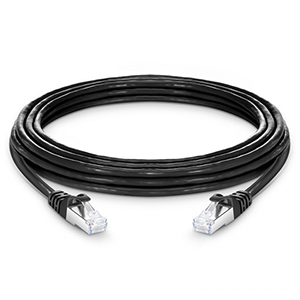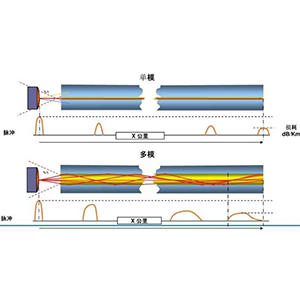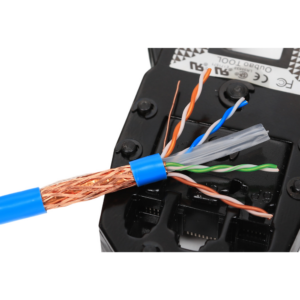I am happy to introduce you to the basic concepts, working principles and applications of LC-LC UPC fiber optic connectors in different fields. As a common fiber optic connector, LC-LC UPC connector has high-quality connection performance and a wide range of applications.
In this article, I will explain to you the definition and basic principles of LC-LC UPC fiber optic connector and help you understand how it realizes connection in fiber optic transmission. At the same time, I will also explain the characteristics and uses of LC-LC UPC fiber optic connector as a common connector, as well as its applications in different fields.
Introduction to LC-LC UPC fiber optic connector
Definition and rationale:
LC-LC UPC fiber optic connector is a common fiber optic connector used to connect two LC type fiber optic patch cords or fiber optic cables. LC stands for “Lucent Connector”, which is a miniaturized optical fiber connector. UPC stands for “Ultra Physical Contact”, which means that its fiber end face has highly precise physical contact.
The basic principle of LC-LC UPC fiber optic connector is to realize the transmission of optical signals through the physical contact of optical fibers. Two LC-type optical fibers are inserted into both ends of the connector. The optical signal of the optical fiber is transmitted through precise alignment and physical contact between the end faces of the connector. The design of the UPC end face can minimize reflection and loss, improving the reliability and performance of the connection.
The optical fiber connector:
LC-LC UPC fiber optic connector has the following features and uses:
-
Miniaturization: LC-LC UPC connectors are relatively small and compact in size, making them suitable for high-density fiber optic cabling environments. It is widely used in data centers, enterprise networks and telecommunications applications.
-
Low insertion loss: LC-LC UPC connectors are designed to achieve precise physical contact and reduce insertion loss of optical signals. This makes it suitable for applications that require higher transmission quality, such as high-speed data transmission and long-distance communications.
-
High reliability: Due to its precise physical contact and low reflection characteristics, the LC-LC UPC connector is able to provide highly reliable fiber optic connections. This is critical to network stability and performance.
-
Flexibility: LC-LC UPC connectors can be used with single-mode and multi-mode optical fibers, suitable for different transmission needs. It can connect fiber optic patch cords, fiber optic cables, and connections between fiber optic equipment.
LC-LC UPC fiber optic connector is a common fiber optic connector type. Its miniaturization, low insertion loss and high reliability make it an ideal choice for a wide range of fiber optic communications and network applications.
Application fields of LC-LC UPC fiber optic connector
local area network:
LC-LC UPC fiber optic connectors are widely used in local area networks (LAN) to provide high-speed, low-loss data transmission. The following are its applications in local area networks:
-
Data transmission: LC-LC UPC connectors can be used to connect network devices such as switches, routers and servers to support high-speed data transmission. It can provide lower insertion loss and higher transmission rate, ensuring network stability and performance.
-
Network expansion: Because the LC-LC UPC connector is small in size and easy to plug and unplug, it is very suitable for expansion and upgrade of the local area network. By connecting LC type optical fiber jumpers, different devices and network nodes can be easily connected to achieve flexible network layout.
data center:
LC-LC UPC fiber optic connectors have important applications in data centers, supporting high-density and high-performance fiber optic connection requirements. The following are its applications in data centers:
-
Server interconnection: Servers in data centers require fast and reliable interconnection to enable high-performance computing and data transmission. LC-LC UPC connectors can provide high bandwidth and low insertion loss connections to meet the needs of fast data exchange between servers.
-
Storage network: Storage devices in data centers usually use optical fiber communications to support the rapid transmission of large-capacity data. LC-LC UPC connectors can be used to connect storage devices, storage area networks (SAN) and network attached storage (NAS), etc., to achieve high-speed and reliable data storage and access.
-
High-density cabling: Data centers often require high-density fiber optic cabling to accommodate the large number of network devices and connection needs. The miniaturized design of the LC-LC UPC connector enables high-density fiber optic connections in limited space and provides flexible cabling solutions.
Overall, LC-LC UPC fiber optic connectors have important applications in both local area networks and data centers. They provide high-speed, low-loss data transmission and support high-density and high-performance optical fiber connection needs, providing reliable solutions for modern communications and networking fields.
Features and advantages of LC-LC UPC fiber optic connector
UPC connection:
LC-LC UPC optical fiber connector adopts UPC (Ultra Physical Contact) connection technology and has the following features and advantages:
-
Low insertion loss: UPC connection technology minimizes the optical signal transmission loss between the end faces of optical fiber connectors through precise physical contact. This means that when the optical signal passes through the connector, the insertion loss is very low and the quality of the optical signal transmission is guaranteed.
-
High-quality transmission: Due to the precise alignment and physical contact of UPC connection technology, LC-LC UPC connectors are able to provide high-quality optical signal transmission. It reduces the reflection and scattering of optical signals and ensures the stability and reliability of optical signals.
Miniaturized design:
LC-LC UPC fiber optic connector adopts miniaturized design and has the following advantages:
-
Space saving: LC-LC UPC connectors are relatively small and compact in size, making them suitable for applications with limited space. In high-density fiber optic cabling environments or inside equipment, LC-LC UPC connectors can utilize space more efficiently and provide flexible cabling solutions.
-
Flexibility: The miniaturized design of the LC-LC UPC connector makes it more flexible and easy to install and operate. They are easy to plug and connect, and are suitable for scenarios where connections need to be frequently changed or adjusted.
-
Convenient installation: Due to its compact design, the LC-LC UPC connector takes up less space during installation and is more convenient to install. This is critical for productivity and ease of deployment or maintenance of fiber optic connections at scale.
To sum up, LC-LC UPC optical fiber connector shows its unique characteristics and advantages through UPC connection technology and miniaturization design. UPC connection technology provides low-loss and high-quality optical signal transmission, and the miniaturized design makes the LC-LC UPC connector suitable for applications with limited space, and provides a flexible and convenient installation and operation experience.
Installation and maintenance of LC-LC UPC fiber optic connector
Connection steps:
The following are the installation steps for LC-LC UPC fiber optic connectors:
-
Fiber preparation: Make sure the fiber end face to be connected is clean and not damaged or contaminated. If necessary, use appropriate tools and cleaners to clean the fiber end face to ensure its optical quality.
-
Connector preparation: Check the end face of the LC-LC UPC connector to ensure it is clean and undamaged. If there is any dirt or contamination, use a clean fiber cleaning rod or fiber cleaner to gently wipe the end face and clean according to the manufacturer’s instructions.
-
Precise alignment: Gently insert the pins of the LC-LC UPC connector into the fiber optic socket to be connected, making sure the insertion direction is correct and the socket is aligned with the pins. Gently rotate the connector until you feel less resistance to insertion.
-
Physical connection: When the socket and pins are aligned, gently push the connector in and make sure the plug is fully inserted into the socket. Make sure the connector is securely connected, but do not use excessive force to avoid damaging the connector or fiber.
-
Test the connection: After completing the connection, use a fiber tester or other appropriate equipment to test the connection to ensure the transmission quality of the optical signal and the reliability of the connection.
Maintenance precautions:
The following are maintenance considerations for LC-LC UPC fiber optic connectors:
-
Regular cleaning: Clean the end face of the LC-LC UPC connector regularly to ensure its optical quality. Clean using a fiber cleaning wand, fiber cleaner, or other appropriate cleaning tool, following manufacturer’s instructions. Avoid using inappropriate cleaners or substances that may damage the cleaning rod.
-
Protect the end face: When the connector is not in use, use an appropriate protective cover or dust cap to protect the end face of the connector from dust, dirt or damage. Make sure the protective cover or dust cap is clean and installed correctly.
-
Avoid pulling: Avoid excessive pulling on connectors and optical fibers to avoid damage or breakage. Use proper grip and avoid using excessive force when connecting or disconnecting connectors.
-
Pay attention to the environment: LC-LC UPC connectors should avoid exposure to moisture, dust or corrosive substances. Make sure connectors are kept in a dry, clean environment to maintain their performance and longevity.
-
Regular inspection: Regularly check the appearance and performance of the LC-LC UPC connector. If any damage, contamination or other abnormalities are found, take appropriate repair or replacement measures promptly.
With correct installation and regular maintenance, LC-LC UPC fiber optic connectors can maintain good performance and reliability, ensuring the quality and stability of fiber optic connections.
LC-LC UPC fiber optic connector compatibility and adapters
Compatibility points:
The compatibility of LC-LC UPC fiber optic connectors mainly involves two aspects:
-
Fiber type: LC-LC UPC connectors are usually used for the connection of single-mode fiber (SMF) and multi-mode fiber (MMF). When selecting an LC-LC UPC connector, you need to ensure that it matches the type of optical fiber used to ensure the transmission quality and compatibility of optical signals.
-
Optical fiber interface: LC-LC UPC connector adopts LC interface, which is a common type of optical fiber interface. In terms of compatibility, you need to ensure that the interface type of the connector matches the interface type of the fiber optic equipment or other connectors. Common LC interface types include LC/PC (Physical Contact), LC/UPC (Ultra Physical Contact) and LC/APC (Angled Physical Contact). When selecting a connector, you need to match it according to actual needs.
Adapters and adapters:
Commonly used adapters and adapters for LC-LC UPC fiber optic connectors can be used to achieve conversion and connection between different interfaces, providing greater flexibility and compatibility. Here are some common adapter and adapter types:
-
LC-LC adapter: used to connect two LC-LC UPC connectors so that they can be directly plugged into the adapter to achieve end-to-end connection of optical fibers.
-
LC-SC adapter: used to convert the LC-LC UPC connector to the SC connector interface type to facilitate connection with equipment using SC connectors.
-
LC-ST adapter: used to convert the LC-LC UPC connector to the ST connector interface type so that it can be connected to devices using ST connectors.
-
LC-MPO/MTP adapter: used to convert LC-LC UPC connector to MPO/MTP connector interface type, suitable for connection between high-density optical fiber cabling system and optical fiber modules.
Adapters and adapters provide interconnection solutions between different interfaces, making the LC-LC UPC fiber optic connector compatible with various fiber optic equipment and interface types, and meeting the needs of different application scenarios. When selecting adapters and adapters, you need to confirm their compatibility and quality, and select and install them according to actual needs.
Application cases of LC-LC UPC fiber optic connectors
Fiber Jumper:
LC-LC UPC fiber optic connectors are widely used in fiber optic patch cords to meet the fiber optic connection needs between devices. The following are some typical application cases:
-
Data center: In a data center environment, LC-LC UPC fiber optic connectors are often used for fiber optic connections between servers, such as the connection between servers and switches. Fiber optic patch cords use LC-LC UPC connectors to provide reliable connection performance and small insertion loss, adapting to the needs of high-speed data transmission.
-
Communication network: LC-LC UPC fiber optic connectors are also widely used in communication networks, such as fiber optic transmission systems, fiber optic distributed antenna systems (DAS), etc. Fast, reliable fiber optic connections are required between devices in these systems, and LC-LC UPC connectors can meet high-quality signal transmission requirements.
-
Enterprise network: In enterprise networks, LC-LC UPC fiber optic connectors are often used for fiber optic cabling of LAN (Local Area Network) and WAN (Wide Area Network), such as the connection between switches and routers, and between network equipment and fiber optic wall panels. Connection etc. Fiber optic patch cords use LC-LC UPC connectors to achieve high-bandwidth, low-latency data transmission.
Optical fiber distribution frame:
The application of LC-LC UPC fiber optic connectors in fiber optic distribution frames can achieve high-density and reliable fiber optic cabling, providing flexible fiber optic connection solutions. The following are some application cases in fiber optic distribution frames:
-
Optical fiber cross-connection: LC-LC UPC optical fiber connector can be used for optical fiber cross-connection in optical fiber distribution frames to achieve interconnection between different optical fibers. This is very important for managing and maintaining fiber optic networks so that the connections between fibers can be flexibly adjusted according to needs.
-
Optical fiber distribution frame: LC-LC UPC optical fiber connector can be used in the optical fiber distribution frame of the optical fiber distribution frame to connect the trunk optical fiber to the branch optical fiber to realize signal distribution and collection. This cabling method enables high-density fiber optic connections and provides flexible expansion and management capabilities.
-
Fiber optic testing and monitoring: In fiber optic distribution frames, LC-LC UPC fiber optic connectors are also used to connect test equipment and monitoring equipment for testing, troubleshooting, and performance monitoring of fiber optic networks. Access and measurement of specific optical fibers can be achieved by plugging and unplugging the connector.
The application cases of LC-LC UPC fiber optic connectors widely cover fields such as data centers, communication networks, and enterprise networks, as well as fiber optic patch cords and cabling in fiber optic distribution frames. These application cases demonstrate the high performance, reliability and adaptability of LC-LC UPC connectors to meet the fiber connection needs in different scenarios.
Summarize:
By reading this article, you will have a deeper understanding of the basic concepts, working principles and applications of LC-LC UPC fiber optic connectors in different fields. As a common fiber optic connector, LC-LC UPC connector has high-quality connection performance and a wide range of applications.
We look forward to exploring the features and advantages of LC-LC UPC fiber optic connectors with you and providing you with high-quality fiber optic connection solutions. If you have any further questions or needs about LC-LC UPC fiber optic connectors, please feel free to contact us. Wishing you better experiences and results in the fiber-connected world!




